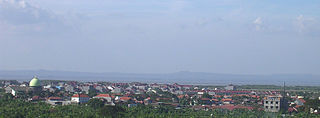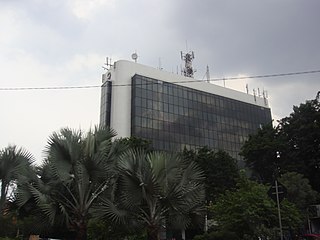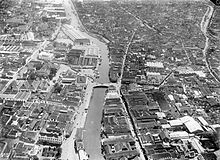
Java is one of the Greater Sunda Islands in Indonesia. It is bordered by the Indian Ocean to the south and the Java Sea to the north. With a population of 156.4 million people, Java is the world's most populous island, home to approximately 56% of the Indonesian population. Indonesia's capital city, Jakarta, is on Java's northwestern coast.

Surabaya is the capital city of the Indonesian province of East Java and the second-largest city in Indonesia, after Jakarta. Located on the northeastern corner of Java island, on the Madura Strait, it is one of the earliest port cities in Southeast Asia. According to the National Development Planning Agency, Surabaya is one of the four main central cities of Indonesia, alongside Jakarta, Medan, and Makassar. The city had a population of 2,874,314 within its city limits at the 2020 census. With 3,009,286 people living in the city as of mid 2023 and over 10 million in the extended Surabaya metropolitan area, according to the latest official estimate, Surabaya was the second-largest metropolitan area in Indonesia. Surabaya metropolitan is also ASEAN's 7th largest economy ahead of Hanoi.

East Java is a province of Indonesia located in the easternmost third of Java island. It has a land border only with the province of Central Java to the west; the Java Sea and the Indian Ocean border its northern and southern coasts, respectively, while the narrow Bali Strait to the east separates Java from Bali by around 2.29 kilometres (1.42 mi). Located in eastern Java, the province also includes the island of Madura, as well as the Kangean islands and other smaller island groups located further east and the Masalembu archipelago to the north. Its capital is Surabaya, the second largest city in Indonesia, a major industrial center and also a major business center. Banyuwangi is the largest regency in East Java and the largest on the island of Java.

The Sultanate of Mataram was the last major independent Javanese kingdom on the island of Java before it was colonised by the Dutch. It was the dominant political force radiating from the interior of Central Java from the late 16th century until the beginning of the 18th century.

Sultan Agung Adi Prabu Anyakrakusuma, commonly known as Sultan Agung, was the third Sultan of Mataram in Central Java ruling from 1613 to 1645. He was a skilled soldier who conquered neighbouring states and expanded and consolidated his kingdom to its greatest territorial and military power.

Kudus is a regency in Central Java province in Indonesia. Its capital is the town of Kudus. It covers 425.15 km2 and is thus the smallest regency on Java Island in area, and it had a population of 777,437 at the 2010 Census and 849,184 at the 2020 Census; the official estimate as at mid 2023 was 874,632, comprising 436,247 males and 438,385 females. It is located northeast of Semarang, the capital of Central Java.

The Solo River is the longest river in the Indonesian island of Java, it is approximately 600 km (370 mi) in length.

Mojokerto is a city in East Java Province of Indonesia. It is located 40 km southwest of Surabaya, the provincial capital, and constitutes one of the component units of the Surabaya metropolitan area which comprises Gresik Regency, Bangkalan Regency, Mojokerto Regency, Mojokerto City, Surabaya City, Sidoarjo Regency, and Lamongan Regency. The city covers an area of 20.21 km2, and had a population of 120,196 at the 2010 census and 132,434 at the 2020 Census; the official estimate as of mid-2023 was 141,785.

Madura Strait is a stretch of water that separates the Indonesian islands of Java and Madura, in the province of East Java. The islands of Kambing, Giliraja, Genteng, and Ketapang lie in the Strait. The Suramadu Bridge, the longest in Indonesia, spans the strait between Surabaya on Java and Bangkalan on Madura.

Gresik Regency is a regency within East Java Province of Indonesia. As well as a large part of the northern and western suburbs of the city of Surabaya, it includes the offshore Bawean Island, some 125 km to the north of Java and Madura. Almost a third of the Gresik Regency's area is the coastal area; the Districts in this zone are Kebomas District, Gresik District, Manyar District, Bungah District, and Ujungpangkah District.

Petrokimia Gresik is a fertilizer company located in Gresik, East Java, Indonesia, which was initially established under the name 'Project of Petrokimia Surabaya'.

Wonokromo is an administrative district (kecamatan) in the city of Surabaya, Indonesia. The Wonokromo railway station serves the area. The Kalimas River originally turned north and empties into the Tanjung Perak and Kali Jagir, a manmade branch of the river that connects east to the sea and includes a dam built by the Dutch. The area is also home to DTC formerly the Wonokromo Market.

The eastern salient of Java is a region that makes up the easternmost part of the island of Java, Indonesia. It is not a formal or administrative subdivision, but rather a designation often used to refer to its distinct history, culture, and geographical feature. It is generally considered to begin in the Tengger mountain range and extend eastwards to the east coast of Java. It is entirely contained by the Indonesian province of East Java.
The Duchy of Surabaya was a Javanese principality centered in Surabaya, on the northeastern coast of Java, that existed as an independent polity from c. 1546 to 1625. It became independent following the disintegration of the Demak Sultanate, and by the beginning of the 17th century had become the leading power in east Java and the most important port on Java's northeastern coast. Subsequently, it entered into decades of conflict with the Mataram Sultanate that ended in the victory of Mataram and the fall of Surabaya in 1625.

The Battle of Surabaya was fought in May 1677 during the Trunajaya rebellion, in which the Dutch East India Company defeated the forces of Trunajaya and took Surabaya on behalf of its ally, the Mataram Sultanate.

Port of Tanjung Perak is the second busiest sea port in Indonesia, located at Surabaya, East Java. It is the main port for the eastern part of the island of Java. The port is accessed from the North through the Madura Strait, a 25-mile (40-kilometer) long, 100-meter (110-yard) wide, and 9.5-meter (31-foot) deep channel between East Java and Madura Island. Because of its strategic position and the existence of surrounding advantageous hinterlands, the port constitutes the center of inter island shipping for Eastern Indonesia. Container terminal of the port is known as Terminal Petikemas. The port loaded and unloaded 3.55 million and 3.8 million TEUs of cargo during 2017 and 2018 respectively.
Java Integrated Industrial and Ports Estate or JIIPE is an industrial area, integrated with deep sea port, residential estate and industrial area at Gresik, East Java, Indonesia. The project is located 24 km from Surabaya. It is a Public Private Partnership development, which is jointly developed by PT Usaha Era Pratama Nusantara, a subsidiary of PT AKR Corporindo Tbk, and PT Berlian Jasa Terminal Indonesia, a subsidiary of state owned company Pelindo III.

Lis-alis is a type of traditional boat of Madura, Indonesia. Lis-alis usually present in canals that provide salt evaporation service in southern part of Madura and around Surabaya. Until the present, lis-alis remained overwhelmingly popular as a fishing craft in Bangkalan and Sukolilo, while a larger version, the kroman, has been used in this area for at least a century for inshore transport work.

There was a tram system in Surabaya, East Java, Indonesia from 1889 to 1978. The tramway was operated by a private company Oost-Java Stoomtram Maatschappij, and later by Kereta Api Indonesia (KAI), and was the only OJS-owned rail system survived in post-independence Indonesia. The tramway linked Ujung with Wonokromo and continued towards Krian in Sidoarjo. All land assets of the tramway is currently owned by Operational Area VII Surabaya of the KAI.

The Submarine Monument, abbreviated as Monkasel, is a museum submarine located in Embong Kaliasin, Genteng, Surabaya. Located 333 in the city center, namely on Jalan Pemuda, right next to Plaza Surabaya, and there is an access door to the mall from within the monument.






















